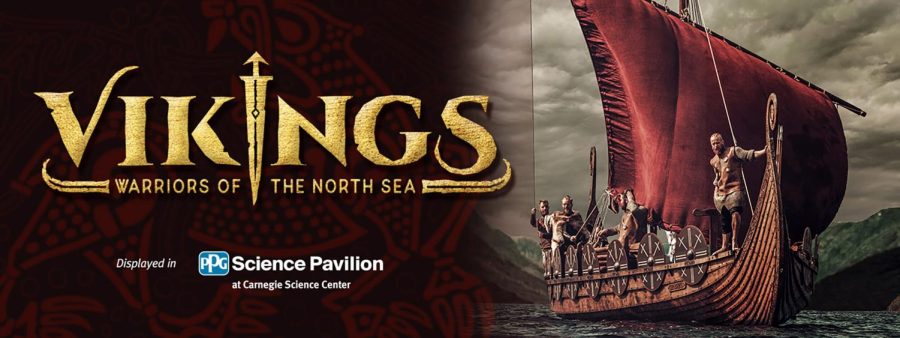Carnegie Science Center sails back in time with newest Viking exhibit
Image via Carnegie Science Center
Poster advertising the Viking exhibit at the Carnegie Science Center.
April 21, 2023
Gold bedazzled chests and iron swords are surrounded by images of sea quests and warriors. A large ship sits at the entrance, drawing guests of all ages to observe the majestic details and artisanry of the Viking Age from a millennium ago.
These displays are a part of the new “VIKINGS: Warriors of the North Sea” exhibit at the Carnegie Science Center, which will run through Sept. 4. The exhibit features more than 140 authentic Viking artifacts, most of which are from The National Museum of Denmark. The exhibit begins with a full-size replica of a Viking boat and extends in a complete circle with videos and interactive displays such as trying on traditional Viking garbs and handling swords.
Connie George, senior director of marketing and community relations at the Carnegie Science Center, said the Center uses different exhibits as a way to introduce people to different cultures while remaining in Pittsburgh.
“We had Pompeii here and Da Vinci,” George said. “Our idea is to bring other parts of the world and other cultures to Pittsburgh where some people who may never get the opportunity to go and visit or to those who aren’t the type to read a history book but would really like to experience this and know more about it.”
George said the exhibit includes tools and items handmade by Vikings. The methods of manufacturing these tools remain a mystery as the Viking Age did not have the technological advances necessary to produce them, according to George.
“They had no technology but created these amazing ships and they were able to sail successfully and raid and trade throughout the world,” George said. “These rivets are some of the rivets that they created, today it would take 1000 man-hours and 400 kilograms of pure iron just to build these rivets for a ship.”
Sarah Maenner, a program presenter at the Carnegie Science Center and a 2022 Pitt graduate, said the exhibit is a great opportunity for growth as it allows her to use her neuroscience and linguistics degree in a professional setting.
“I came here to get a foot in the door for science communication. I was so excited when they announced the exhibit,” Maenner said. “I’ve been able to bring in my other degree by teaching the team how to pronounce Scandinavian words.”
According to Maenner, the exhibit attempts to display the domestic work performed by women during the Viking age as what held society together at the time. Maenner said Vikings also recognized women as having roles beyond their homes, including as raiders and warriors.
“All of the clothes were made out of wool. Women spent a lot of time spinning and weaving which was the backbone of society,” Maenner said. “Every once in a while, a woman would go out and cross gender roles, such as the woman Viking warrior in the exhibit.”
Judy Curran, a Pittsburgh local and visitor of the exhibit, shared that she is astounded by the items and artifacts at the exhibit and believes the exhibit teaches facts that are unknown to many people and corrects misconceptions about vikings.
“I’m astounded by the artifacts that have survived the years and years of weather and water and cold. They have pieces here that men carried into battle, and it’s just phenomenal,” Curran said. “I truly am impressed. What you think you know about Vikings from stories and pictures and then coming to see the truth. For example, everyone thinks of Viking helmets with horns on them, and they never had horns on them.”
As a retiree, Curran said she thinks the exhibit is a must-have experience and thinks college students should take the opportunity to visit the exhibit and grow their horizons. Even if it’s unrelated to academics, the exhibit can teach students a lot.
“I would without a doubt recommend this exhibit to college students, here we are with this world-renowned exhibit, why wouldn’t you come?” Curran said. “My father once told me to learn everything you can learn, even if you don’t use it today, someday you will call on it.”



